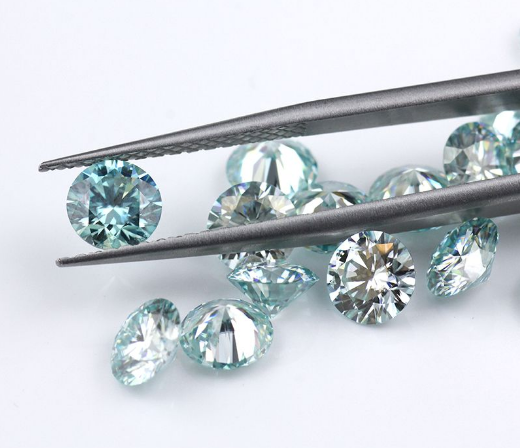Moissanite and diamonds are two popular gemstones that are often compared due to their similarities in appearance. While they both possess exceptional beauty and are commonly used in jewelry, there are distinct differences between moissanite and diamonds. Let's explore these differences in more detail:
Composition:
Moissanite is composed of silicon carbide (SiC), a naturally occurring mineral that is extremely rare in nature. It was first discovered in a meteor crater in Arizona in 1893.
On the other hand, diamonds are made entirely of carbon, which is the same element that forms the basis of all organic life on Earth. The difference in composition results in variations in their physical and optical properties.
Appearance:
To the naked eye, moissanite and diamonds can appear quite similar, especially when they are well-cut and polished. Both gemstones can exhibit exceptional brilliance and sparkle, creating a dazzling visual effect. However, there are some subtle differences in their optical properties.
Moissanite has a higher refractive index than diamonds, meaning it has greater light-bending capabilities. As a result, moissanite can exhibit more fire and flashes of color compared to diamonds. Some people find the rainbow-like flashes of color in moissanite appealing, while others prefer the classic white sparkle of diamonds. The choice between the two often comes down to personal preference.

Blue Color Round Brilliant Cut Moissanite
Durability:
Diamonds are renowned for their exceptional hardness and durability. They rank as the hardest known substance on the Mohs scale of mineral hardness, with a rating of 10 out of 10. This means that diamonds are highly resistant to scratching and can withstand daily wear without easily getting damaged.
Moissanite, although not as hard as diamonds, is still a highly durable gemstone. It ranks around 9.25 to 9.5 on the Mohs scale, making it one of the hardest gemstones available for jewelry. Both moissanite and diamonds are suitable for everyday wear, but diamonds are slightly more resistant to scratches and abrasions.
Color:
When it comes to color, diamonds exhibit a wide range of hues. They can be colorless, but most diamonds have a slight tint of yellow or brown. However, diamonds can also exhibit rare and prized color saturations, such as blue, pink, green, or even fancy intense and fancy vivid colors. The Gemological Institute of America (GIA) grades diamonds on a color scale from D (colorless) to Z (light yellow or brown).
In contrast, moissanite stone is typically near-colorless, meaning it appears colorless to the naked eye. However, moissanite can exhibit a slight yellow or greenish tint in certain lighting conditions. Some individuals prefer the colorless appearance of moissanite, while others appreciate the variety of colors available in diamonds.
Price:
Price is often a significant factor when considering moissanite versus diamonds. Moissanite is generally more affordable than diamonds, offering a similar look at a lower cost. The price of diamonds can vary greatly based on several factors, including carat weight, cut, color, and clarity. Natural diamonds are typically more expensive than lab-created diamonds, which are an alternative to consider when looking for a more budget-friendly option. Moissanite provides an attractive alternative for individuals who want a larger and more visually impressive stone for the price compared to a diamond of the same carat weight.
Ethical and Environmental Considerations:
In recent years, ethical and environmental considerations have become increasingly important for many consumers. Some individuals may choose moissanite over diamonds due to concerns about the diamond industry's environmental impact and issues related to conflict diamonds. Moissanite is a lab-created gemstone, meaning it is grown in a controlled laboratory environment. Lab-created diamonds are also available as an ethical and sustainable alternative to mined diamonds. These options allow individuals to choose a gemstone that aligns with their values and preferences.
Conclusion
Moissanite and diamonds are both stunning gemstone options, each with its own unique characteristics. Moissanite offers exceptional brilliance and durability at a more affordable price point compared to diamonds. On the other hand, diamonds have a long-standing reputation for their hardness, rarity, and timeless appeal. When choosing between moissanite and diamonds, it ultimately comes down to personal preference, budget, and individual values. Whether you opt for the rainbow-like fire of moissanite or the classic beauty of diamonds, both gemstones can create breathtaking jewelry pieces that are sure to be cherished for years to come.



 Lab Grown Emerald
Lab Grown Emerald


